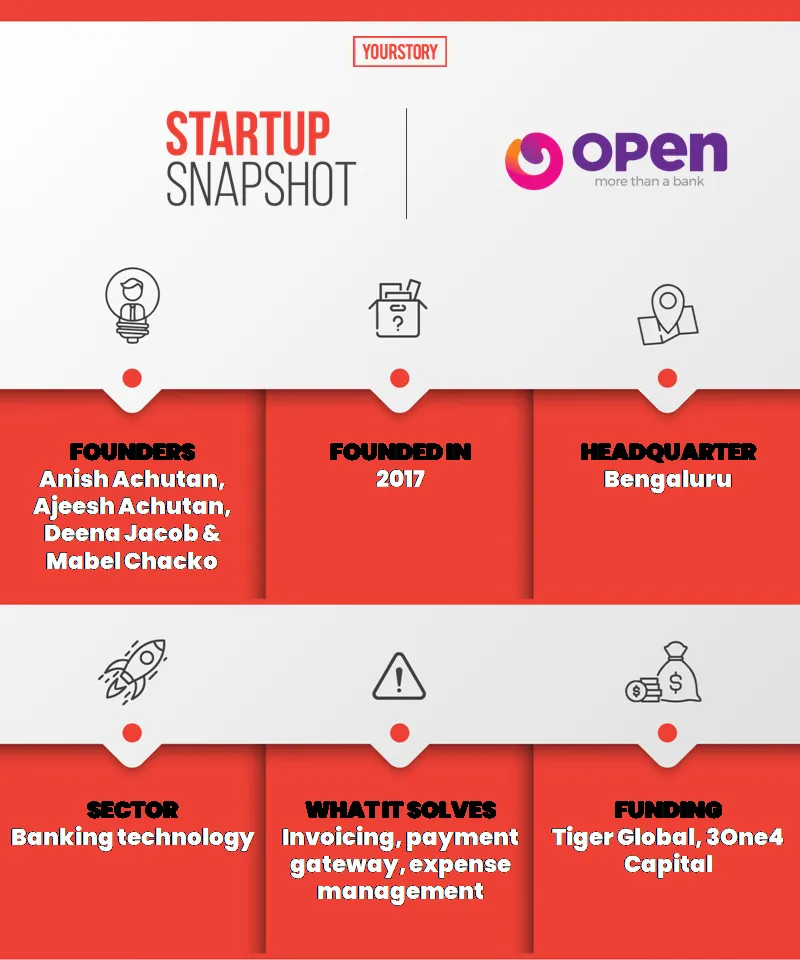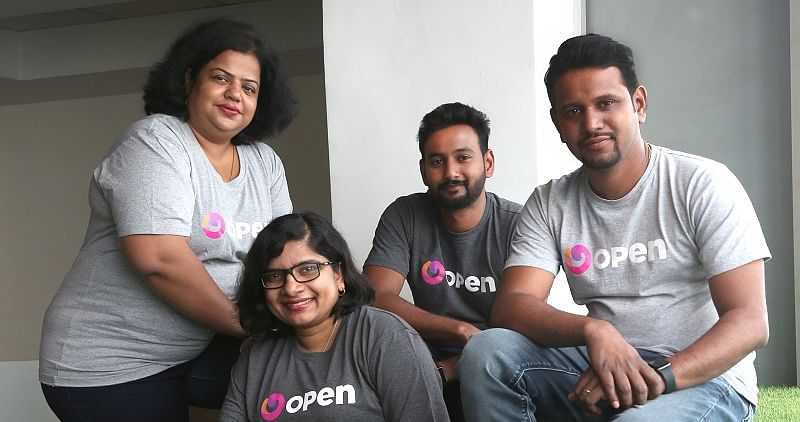SMBs are the lifeline of the Indian economy, and we have seen it first-hand in the last year amidst the pandemic, when several of them rose to the occasion to arm India with essential equipment at short notice. The Ministry of Commerce, Government of India, pegs SMB contribution to 30 percent of India’s GDP. The sector is also the second largest employer after agriculture.
However, one pressing problem every SMB owner encounters is managing their current account. Current account management can be automated to manage invoicing, payouts, payroll and accounting, albeit with the right expertise support.
Open, a fintech platform, has tapped into this gap in the SMB business finance segment. It offers a business account in partnership with banks that helps SMEs automate and run their finances effectively. Being a neobank, Open allows companies to open accounts digitally.
Open was founded by Anish Achuthan along with Ajeesh Achuthan, Deena Jacob and Mabel Chacko in May 2017. Anish, Ajeesh and Mabel had launched three fintech startups prior to Open, including, Cashnxt (branchless banking), Neartivity Wireless (NFC Payments) and Zwitch (Developer payment gateway). The founders also have experience working in various fintech organisations over the last decade.

Snapshot
Anish, Ajeesh and Mabel thought about creating a bank account particularly for SMEs that would be an effective tool for them to automate their process of managing finances. When they discussed it with Deena, she instantly agreed with the idea and vision. Deena’s previous experience included being the CFO at Tapzo (acquired by Amazon), and she also held various positions at TaxiforSure (acquired by OLA), and Zansaar.com (acquired by HomeLane).
“Different neobanks offer different services to their customers based on their business model. In the case of Open, it provides invoicing, payment gateway, expense management, and payroll service on a single dashboard. In many markets, like Europe for example, neobanking rose due to open banking norms being implemented by the regulator around PSD2 guidelines,” says Ajeesh.
In India, the need for neobanking platforms stems from strong expectations for cost-effective, personalised and accessible banking solutions that also incorporate multiple functionalities like tools to manage and grow a business. In terms of opportunity, there is enough scope for innovations in neobanking to come in for various segments of customers – both on the consumer banking and business banking side.
The product
Open offers SMEs a business account in partnership with banks that helps the companies automate and run their finances effectively. “The platform enables businesses to collect payments, make seamless payouts, auto-reconcile, categorise income and expenses, thereby automating bookkeeping. It also offers APIs to integrate banking into business workflows,” says Anish Achuthan, co-founder of Open.
“We initially started with one bank. Today, we have around 18 banks as partners for various parts of the Open platform. We also have banks deploying our enterprise version for their customers,” says Deena.
Open has raised $35 million in three rounds (seed+A+B) with key investors such as Tiger Global, Speedinvest, 3one4 Capital, Unicorn India Ventures, Recruit, Amrish Rau and Jitendra Gupta (former PayU India).
Open’s journey has been immensely rewarding thus far, but like with any entrepreneurial journey, there have been challenges along the way. “I distinctly remember how difficult it was in the early days to get a banking partner onboard. Particularly since the concept of neobanking was so new to India. Today, I am pleased to say that we have over 18 banking partners with us. Since we were the first mover across the industry in Asia, we had to navigate our way, and learn on the journey,” says Anish.
The company competes with RazorPay’s current account platform called RazorPayX, and also with Niyo, SBI Yono and Insta Pay.
According to PWC, the global neobank market was worth $18.6 billion in 2018, and is expected to accelerate at a compounded annual growth rate (CAGR) of around 46.5 percent between 2019 and 2026, generating around $394.6 billion by 2026.
Open does not want to disclose its revenues as it is privately held.
The business
While 80 percent of the services provided by Open continue to be free, some services are based on a freemium model.
Also, the basic functions are free but if an SMB needs expense management for more than 10 employees, then the startup charges the SMB on a pay as you use model.
The startup has built its tech on Nodejs, PHP, GoLang and AngularJS on the application side. Other platform technologies they use are AWS, Kafka, and Redis.
“We want to be the go-to platform for businesses when it comes to digital banking in partnership with banks. Our vision is to bring on board 15 lakh SMEs on the platform by September 2021. We also want to help them in providing more value to their businesses,” says Ajeesh.
In the next 18 months, Open will help SMBs with working capital requirements since they have a lot of data available from these businesses like tax payment, and the frequency with which they pay out vendors. With the pandemic leading to a liquidity crisis, banks and NBFCs are cautious to lend to SMEs. This is where the balance sheet information will be helpful for SMBs for tailored access to credit.
Secondly, businesses don’t earn any interest on current accounts in India, and most of the banks do not have the expertise for treasury management of a liquid fund or a mutual fund.
The startup claims to be serving more than 700,000 plus SMEs currently, and processing $15 billion in transactions annually. They aim to onboard 50,000 SMEs and startups every month.
Open’s automated banking proposition saves hours of time for business owners and finance teams, thus allowing them to focus on their core business.









